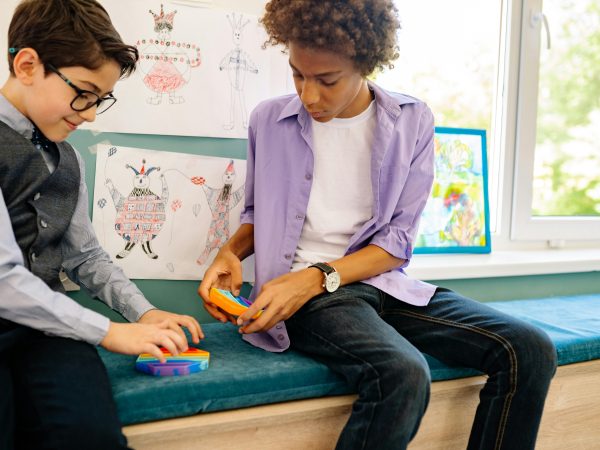You buy a fidget spinner hoping it’ll help your child focus – but instead, it becomes the centre of attention in class. Sound familiar?
Fidgets are everywhere, but not all of them actually help. For kids with ADHD, the right fidget can support concentration, calm the nervous system, and offer a discreet outlet for excess energy. But the wrong one can distract, stigmatise, or even backfire – especially if it doesn’t match your child’s sensory needs or personality.
In this guide, we’ll walk you through how to choose effective, classroom-friendly, and gender-inclusive fidgets that support regulation and focus – not just fads.
What Fidgets Are (and Aren’t)
Fidgets are self-regulation tools, not toys. They’re designed to help the nervous system stay engaged and alert by providing controlled sensory input—through movement, touch, or pressure.
For many kids with ADHD, using a fidget can help channel physical energy, reduce stress, and improve focus—especially during long periods of listening or sitting still. But effectiveness depends on how the fidget is used and whether it suits the child’s needs.
It’s not about keeping hands busy just for the sake of it—it’s about helping the brain find balance.
How to Choose the Right Fidget
Choosing a fidget isn’t one-size-fits-all. Here are four key things to consider:
1. Setting
Will it be used in a classroom, at home, during therapy, or on-the-go? Fidgets that work well in quiet classrooms need to be silent and non-distracting. Others, like heavy resistance putty, might be great for home use.
2. Sensory Needs
Some kids seek tactile input (textures, resistance), others need proprioceptive input (deep pressure or movement). Others might prefer oral or visual sensory tools. Choose based on what calms or grounds your child—not just what’s trending.
3. Gender-Inclusive Design
Avoid assumptions like “boys need to move” or “girls fidget with their hair.” Kids of all genders can benefit from movement, texture, pressure, or chewing tools. Let your child guide the choice, not gendered marketing.
4. ADHD Presentation
Hyperactive kids might need movement-oriented tools (like chair bands), while inattentive kids may benefit from something to hold quietly (like a textured ring or putty). Anxiety or sensory sensitivity may also influence preference.
Top 8 Fidgets That Actually Help (and Why)
Here’s a list of tried-and-true fidgets, suitable for a range of ages, genders, and settings:
1. Tangle Toys
Twistable, looped plastic toys that offer smooth, repetitive motion. Great for calming the mind without distracting others.
Best for: Quiet focus, sensory-seeking hands
Classroom-friendly: ✅
2. Fidget Rings
Spinning or textured rings worn like jewellery. Discreet and perfect for older kids or those who mask their symptoms.
Best for: Inattentive types, anxious kids
Classroom-friendly: ✅
3. Therapy Putty / Fidget Putty
Soft or resistive putty provides tactile and proprioceptive input. Helps release energy through squeezing or stretching.
Best for: Home use, stress relief
Classroom-friendly: ❌ (can be messy)
4. Chewelry (Chewable Jewellery)
Silicone pendants or bracelets for oral sensory input. Look like regular accessories.
Best for: Oral seekers, anxious nibblers
Classroom-friendly: ✅ (with hygiene considerations)
5. Chair Bands / Foot Fidgets
Elastic bands that stretch across chair legs for quiet bouncing or pushing with feet.
Best for: Kids who need to move while seated
Classroom-friendly: ✅
6. Weighted Lap Pads
Provide deep pressure input to promote calm and body awareness during seated tasks.
Best for: Sensory-seeking or dysregulated kids
Classroom-friendly: ✅ (if discreet and approved)
7. Textured Pencil Grips
Small but effective, these grips offer tactile stimulation and improve focus during writing tasks.
Best for: Fine motor tasks, writing anxiety
Classroom-friendly: ✅
8. Silent Clickers or Push Poppers
Low-sound push toys or clickers that offer rhythmic motion and sensory feedback.
Best for: Repetitive movement needs
Classroom-friendly: ✅ (choose silent versions only)
What to Avoid: Fidget Fails
Not all “fidget toys” are helpful—some do more harm than good. Avoid:
-
Noisy, flashy toys – Light-up cubes or loud poppers distract others and invite negative attention.
-
Overly stimulating gadgets – If a fidget becomes the main focus, it’s not doing its job.
-
Reinforcing stereotypes – Avoid gendered language like “boys will be boys” or “this is for girls who daydream.”
The goal is support, not entertainment or labelling.
Involve Kids in Choosing (and Using) Their Tools
Empowering kids to choose their own fidgets increases the chance they’ll use them effectively. Let them try different options and reflect on how each one makes them feel:
-
“Does this help you concentrate or make it harder?”
-
“Do you feel calmer when you use this?”
Teach them when and how to use fidgets respectfully—especially in shared spaces like classrooms. Practice at home before introducing it at school.
The right fidget isn’t a cure, but it can be a game-changer. When chosen thoughtfully, fidgets can help kids with ADHD feel more focused, less anxious, and better equipped to thrive in their day-to-day environments.
There’s no one-size-fits-all. Trust your child, stay flexible, and don’t be afraid to experiment until you find what fits best.

